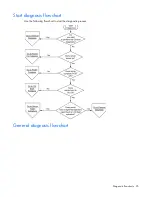
Getting started 13
When additional information becomes necessary, use this section to identify websites and
supplemental documents that contain troubleshooting information.
•
Error messages (on page
92
)
Use this section for a complete list of the following messages:
o
ADU error messages (on page
92
)
o
POST error messages and beep codes (on page
116
)
o
Event list error messages (on page
159
)
o
HP BladeSystem infrastructure error codes ("
HP BladeSystem p-Class infrastructure error codes
" on
page
162
)
o
Port 85 codes and iLO messages (on page
167
)
Pre-diagnostic steps
WARNING:
To avoid potential problems, ALWAYS read the warnings and cautionary
information in the server documentation before removing, replacing, reseating, or modifying
system components.
IMPORTANT:
This guide provides information for multiple servers. Some information may not
apply to the server you are troubleshooting. Refer to the server documentation for information on
procedures, hardware options, software tools, and operating systems supported by the server.
1.
Review the important safety information (on page
13
).
2.
Gather symptom information (on page
16
).
3.
Prepare the server for diagnosis (on page
16
).
4.
Use the Start diagnosis flowchart (on page
25
) to begin the diagnostic process.
Important safety information
Familiarize yourself with the safety information in the following sections before troubleshooting the server.
Important safety information
Before servicing this product, read the
Important Safety Information
document provided with the server.
Symbols on equipment
The following symbols may be placed on equipment to indicate the presence of potentially hazardous
conditions.
This symbol indicates the presence of hazardous energy circuits or electric shock
hazards. Refer all servicing to qualified personnel.
WARNING:
To reduce the risk of injury from electric shock hazards, do not open this
enclosure. Refer all maintenance, upgrades, and servicing to qualified personnel.














































